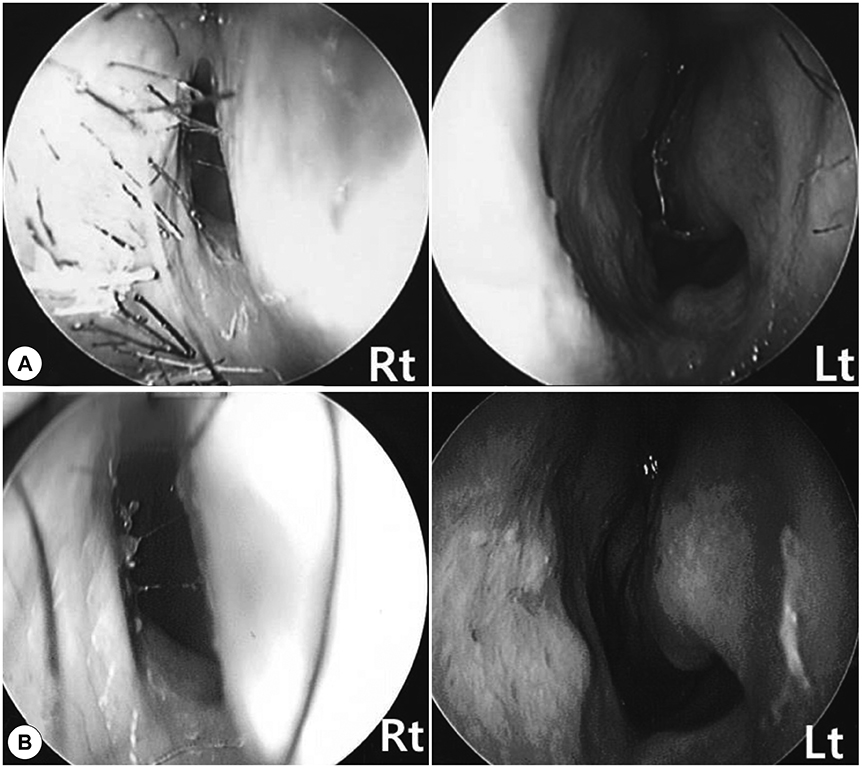J Rhinol.
2019 May;26(1):16-20. 10.18787/jr.2019.26.1.16.
Usefulness of Unilateral Nasal Packing for Recurred Septal Deviation within a Month after Septoplasty: Preliminary Study
- Affiliations
-
- 1Student, Gachon University School of Medicine, Incheon, Korea.
- 2Department of Otolaryngology-Head and Neck Surgery, Inje University Seoul Paik Hospital, Seoul, Korea.
- 3Department of Otolaryngology-Head & Neck Surgery, Medical Faculty, Gil Medical Center, Gachon University, Incheon, Korea. eyik@naver.com
- KMID: 2449023
- DOI: http://doi.org/10.18787/jr.2019.26.1.16
Abstract
- BACKGROUND AND OBJECTIVES
To investigate the effect of unilateral nasal packing on the correction of recurred septal deviation after septoplasty. MATERIALS AND METHOD: We analyzed 12 patients who had undergone septoplasty and developed septal deviation recurrence. Polyvinylacetate and Vaseline gauze were inserted into the nasal passage on the convex side of the septum for 4 days in order to shift the septum to the midline. We analyzed nasal symptoms, acoustic rhinometric results, and endoscopic findings before and after unilateral packing in order to evaluate the treatment outcomes.
RESULTS
Ten (83%) out of 12 patients showed improvements in nasal obstruction, acoustic rhinometric results, and endoscopic findings. The mean visual analogue scale (VAS) score for nasal obstruction was 5.25±1.60 before and 2.08±1.50 after packing (p=0.004). The minimal cross-sectional area (MCA) improved from 0.17±0.14 to 0.27±0.13 (p=0.002), and the mean endoscopic score improved from 2.0±0.43 to 1.08±0.29 (p=0.002).
CONCLUSION
Unilateral nasal packing was a safe, easy, and effective method for correcting recurred septal deviation after septoplasty.
Keyword
MeSH Terms
Figure
Reference
-
1. Siegel NS, Gliklich RE, Taghizadeh F, Chang Y. Outcomes of septoplasty. Otolaryngol Head Neck Surg. 2000; 122:228–232.
Article2. Thomas JN. S.M.R.—a two-year follow-up survey. J Laryngol Otol. 1978; 92:661–666.
Article3. Illum P. Septoplasty and compensatory inferior turbinate hypertrophy: Long-term results after randomized turbinoplasty. Eur Arch Otorhinolaryngol. 1997; 254:suppl 1. S89.
Article4. Fjermedal O, Saunte C, Pederson S. Septoplasty and/or submucous resection? 5 years nasal septum operations. J Laryngol Otol. 1988; 102:796–798.5. Sillers MJ, Cox AJ 3rd, Kulbersh B. Revision septoplasty. Otolaryngol Clin North Am. 2009; 42(2):261–278.
Article6. Kim YD. Septoplasty and Turbinoplasty; Current Concept and Technique. J Rhinol. 2012; 19(1):19–28.7. Jin HR, Won TB. Septoplasty; Current Concept and Technique. Septoplasty. J Rhinol. 2008; 15(1):13–29.8. Dinis PB, Haider H. Septoplasty: Long term evaluation of results. Am J Otolaryngol. 2002; 23:85–90.9. Kang IG, Jung JH, Woo JH, Cha HE, Kim ST. The effect of expandable polyvinyl acetate packing for preventing stenosis of the frontal sinus ostium. Am J Rhinol Allergy. 2010; 24(5):392–395.
Article10. Kang JM, Nam ME, Dhong HJ, Kim HY, Chung SK, Kim JH. Modified mattress suturing technique for correcting the septal high dorsal deviation around the keystone area. Am J Rhinol Allergy. 2012; 26(3):227–232.
Article11. Lawson W, Westreich R. Correction of caudal deflections of the nasal septum with a modified Goldman septoplasty technique: how we do it. Ear Nose Throat J. 2007; 86(10):617–620.
Article12. Yang JW, Kim SI, Kwon JW, Park DJ. Are Cross-hatching Incisions Mandatory for Correction of Cartilaginous Septal Deviation? Clin Exp Otorhinolaryngol. 2008; 1(1):20–23.
Article
- Full Text Links
- Actions
-
Cited
- CITED
-
- Close
- Share
- Similar articles
-
- Comparison of Nasal Packing and Septal Suturing Following Septoplasty
- Septal deviation correction methods and surgical considerations in turbinoplasty
- The Usefulness of Latex-covered Merocel(R) Packing in Septal Surgery
- Clinical Outcome Study after External Approach Septoplasty
- Revision and Reconstructive Septoplasty



